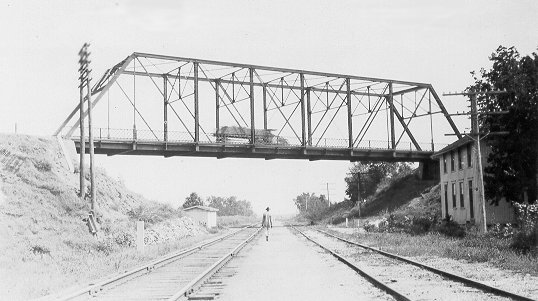|
|
PRATT PONY TRUSS
1900 Canadian 09N2820E1110009 Kansas City Br.
1905 Payne 60E0690N3190004 Midland Br.
1909 Noble 52E0470N3230007 J.A. Crook
1909 Washington 74E0330N3980001 Missouri Valley Br.
1910 Payne 60N3300E0530009 Wichita Const.
1911 Washington 74N4025E0300007 Rochester Br.
1912 Hughes 32N3820E1510006 Missouri Valley Br.
1913 Creek 19E0815N3720005 Kansas City Br.
1913 Payne 60E0620N3510006 Canton Br.
1915 Alfalfa 02E0090N2680009 Kansas City Br.
1915 Comanche 16N2470E1730007 Boardman Co.
1916 Alfalfa 02E0280N2510004 C.G. Landon
1918 Latimer 39N4520E1370005 Boardman Co.
1921 Bryan 07N3650E2190009 General Const.
The Pratt pony truss in its more conventional form, with inclined endposts and connected by pins, greatly contributed to improving the early roads of Oklahoma as it did elsewhere. In lengths between 50 and 100 feet it enjoyed wide acceptance as a reliable and uncomplicated span in the years preceeding World War One. The type could also be found in the inventory of all national and most regional builders, thus making it readily available and promptly shipped to construction sites. One of the state's oldest documented bridges is a Pratt pony built by Kansas City Bridge in 1900 to cross a stream west of Union City, serving a typical purpose for that time by giving farmers safe passage for their wagons to local markets.
Pratt ponies represent the work of many significant builders in the state, including the prominent Oklahoma City firm, the Boardman Company, and a few strictly regional companies whose structures are scarce. J. A. Cook if Falls City, Nebraska, successfully contracted in north central Oklahoma early in this century and built a 96-foot Pratt in Noble County during 1909.
|
| Figure 49. Bridge 60N3300E0530009, a rare example of a truss biult by the Wichita Construction Company, is a 1910 Pratt pony span. It stands northwest of the Stillwater Municipal Airport.
|

|
|
Qualifying as a rare example in the state because of its builder is a Pratt pony span, dating from 1910 and located near Stillwater, that was produced by the Wichita (Kansas) Construction Company (Figure 49). The company's brief existence ended in bankruptcy in 1913. Many of these companies, operating out of small country towns, could compete with their bigger national rivals during the early 1900s, but their days were numbered, and few made it into the 1920s.
All builders tended to make Oklahoma's Pratt pony spans with laced channel top chords, eyebar bottom chords, angles in the verticals, and pinned connections. The presence of bolts in some early trusses is often treated as a sign of a moved structure or extensive repairs, prehaps resulting from a collapse. Yet it also illustrates one of the great virtues of truss spans, they were designed to be dimantled, moved, and rebuilt at another site, sparing the expense of a new bridge.
|
|
|
|



